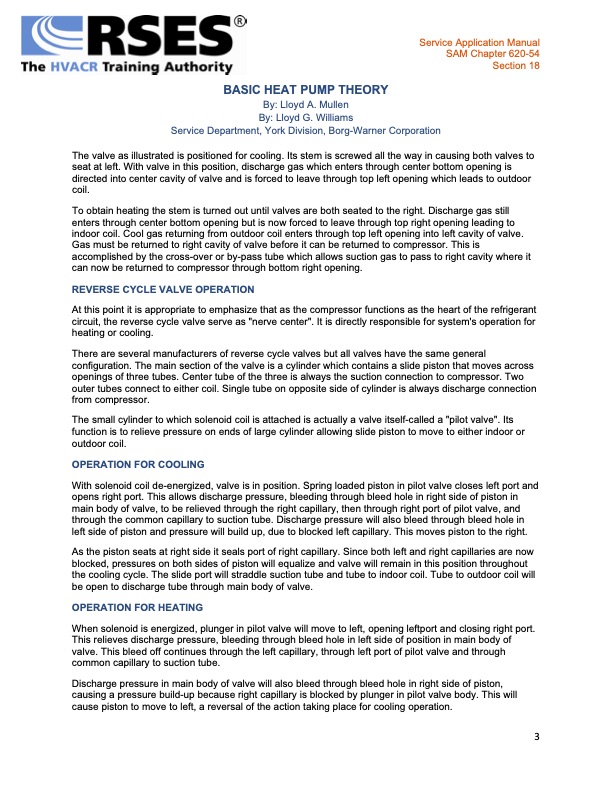
PDF Publication Title:
Text from PDF Page: 003
BASIC HEAT PUMP THEORY By: Lloyd A. Mullen By: Lloyd G. Williams Service Department, York Division, Borg-Warner Corporation The valve as illustrated is positioned for cooling. Its stem is screwed all the way in causing both valves to seat at left. With valve in this position, discharge gas which enters through center bottom opening is directed into center cavity of valve and is forced to leave through top left opening which leads to outdoor coil. To obtain heating the stem is turned out until valves are both seated to the right. Discharge gas still enters through center bottom opening but is now forced to leave through top right opening leading to indoor coil. Cool gas returning from outdoor coil enters through top left opening into left cavity of valve. Gas must be returned to right cavity of valve before it can be returned to compressor. This is accomplished by the cross-over or by-pass tube which allows suction gas to pass to right cavity where it can now be returned to compressor through bottom right opening. REVERSE CYCLE VALVE OPERATION At this point it is appropriate to emphasize that as the compressor functions as the heart of the refrigerant circuit, the reverse cycle valve serve as "nerve center". It is directly responsible for system's operation for heating or cooling. There are several manufacturers of reverse cycle valves but all valves have the same general configuration. The main section of the valve is a cylinder which contains a slide piston that moves across openings of three tubes. Center tube of the three is always the suction connection to compressor. Two outer tubes connect to either coil. Single tube on opposite side of cylinder is always discharge connection from compressor. The small cylinder to which solenoid coil is attached is actually a valve itself-called a "pilot valve". Its function is to relieve pressure on ends of large cylinder allowing slide piston to move to either indoor or outdoor coil. OPERATION FOR COOLING With solenoid coil de-energized, valve is in position. Spring loaded piston in pilot valve closes left port and opens right port. This allows discharge pressure, bleeding through bleed hole in right side of piston in main body of valve, to be relieved through the right capillary, then through right port of pilot valve, and through the common capillary to suction tube. Discharge pressure will also bleed through bleed hole in left side of piston and pressure will build up, due to blocked left capillary. This moves piston to the right. As the piston seats at right side it seals port of right capillary. Since both left and right capillaries are now blocked, pressures on both sides of piston will equalize and valve will remain in this position throughout the cooling cycle. The slide port will straddle suction tube and tube to indoor coil. Tube to outdoor coil will be open to discharge tube through main body of valve. OPERATION FOR HEATING When solenoid is energized, plunger in pilot valve will move to left, opening leftport and closing right port. This relieves discharge pressure, bleeding through bleed hole in left side of position in main body of valve. This bleed off continues through the left capillary, through left port of pilot valve and through common capillary to suction tube. Discharge pressure in main body of valve will also bleed through bleed hole in right side of piston, causing a pressure build-up because right capillary is blocked by plunger in pilot valve body. This will cause piston to move to left, a reversal of the action taking place for cooling operation. Service Application Manual SAM Chapter 620-54 Section 18 3PDF Image | BASIC HEAT PUMP THEORY INTRO

PDF Search Title:
BASIC HEAT PUMP THEORY INTROOriginal File Name Searched:
620-54.pdfDIY PDF Search: Google It | Yahoo | Bing
CO2 Organic Rankine Cycle Experimenter Platform The supercritical CO2 phase change system is both a heat pump and organic rankine cycle which can be used for those purposes and as a supercritical extractor for advanced subcritical and supercritical extraction technology. Uses include producing nanoparticles, precious metal CO2 extraction, lithium battery recycling, and other applications... More Info
Heat Pumps CO2 ORC Heat Pump System Platform More Info
| CONTACT TEL: 608-238-6001 Email: greg@infinityturbine.com | RSS | AMP |